
Andrea del Brescianino or Dei Piccinelli was an Italian painter of the Renaissance period, active mainly in Siena. Together with his brother Raffaello they were known as the Brescianini of Siena.

Andrea del Brescianino or Dei Piccinelli was an Italian painter of the Renaissance period, active mainly in Siena. Together with his brother Raffaello they were known as the Brescianini of Siena.
He was the son of a dancing-master at Siena, where he flourished from 1507 to 1525. He was the pupil of a Sienese painter, named Giovanni Battista Giusi, and they together painted an altar-piece, representing the Virgin and Child, with Saints, which is in the Siena Academy. In 1524, he painted the Baptism of Christ for the baptistery of the cathedral of the same city. In 1525 the brothers went to Florence, and in the same year Andrea, and probably Raffaello also, was registered in the Painters' Guild. A Holy Family by Andrea, who was the better artist of the two, is in the Uffizi Gallery at Florence, and another Holy Family, ascribed to him, is in the Berlin Gallery. The beautiful altar-piece, a Holy Family displayed at the church of Torre di Bibiano, long attributed to Baldassare Peruzzi, has been attributed to Andrea. The brothers appear to have worked under the influence of Fra Bartolommeo.

Il Sodoma was the name given to the Italian Renaissance painter Giovanni Antonio Bazzi. Il Sodoma painted in a manner that superimposed the High Renaissance style of early 16th-century Rome onto the traditions of the provincial Sienese school; he spent the bulk of his professional life in Siena, with two periods in Rome.
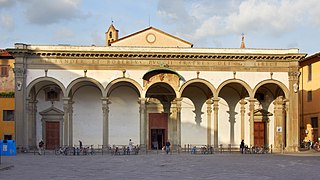
The Basilica della Santissima Annunziata is a Renaissance-style, Catholic minor basilica in Florence, region of Tuscany, Italy. This is considered the mother church of the Servite Order. It is located at the northeastern side of the Piazza Santissima Annunziata near the city center.
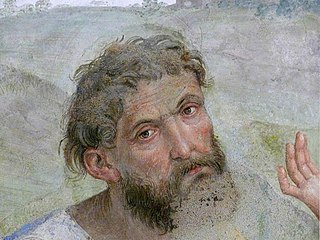
Lo Spagna, "the Spaniard" in Italian, was a painter of the High Renaissance, active in central Italy. His name was Giovanni di Pietro, but he was known as Lo Spagna because he was born in Spain. After Raphael, he was a main pupil and follower of the Umbrian painter Perugino, whose style his paintings developed. He should not be confused with Pietro di Giovanni D'Ambrogio of Siena.
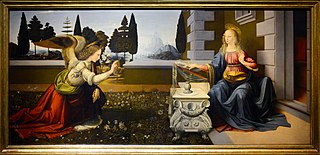
The Annunciation is a painting by the Italian Renaissance artist Leonardo da Vinci, dated to c. 1472–1476. Leonardo's earliest extant major work, it was completed in Florence while he was an apprentice in the studio of Andrea del Verrocchio. The painting was made using oil and tempera on a large poplar panel and depicts the Annunciation, a popular biblical subject in 15th-century Florence. Since 1867 it has been housed in the Uffizi in Florence, the city where it was created. Though the work has been criticized for inaccuracies in its composition, it is among the best-known portrayals of the Annunciation in Christian art.

Raffaellino del Garbo (1466–1527) was a Florentine painter of the early Renaissance.
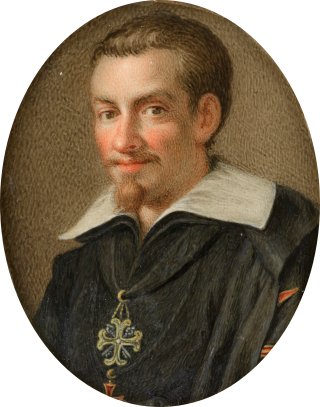
Francesco Vanni was an Italian painter, draughtsman, printmaker, publisher and printer active in Rome and his native city of Siena.
Francesco Botticini was an Italian painter of the Early Renaissance. He was born in Florence, where he remained active until his death in 1498. Although there are only few documented works by Botticini, a considerable corpus has been confidently attributed to him on the basis of style including a number of altarpieces, dozens of small-scale religious panels and a few portraits.
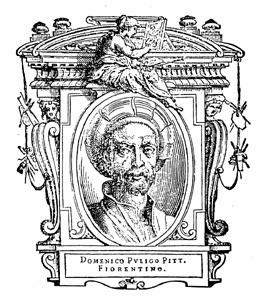
Domenico Puligo (1492–1527) was an Italian painter of the Renaissance, active in Florence. His real name was Domenico di Bartolomeo Ubaldini.

Marcello Venusti was an Italian Mannerist painter active in Rome in the mid-16th century.
Raffaello da Montelupo, born Raffaele Sinibaldi, was a sculptor and architect of the Italian Renaissance, and an apprentice of Michelangelo. He was the son of another Italian sculptor, Baccio da Montelupo. Both father and son are profiled in Vasari's Le Vite delle più eccellenti pittori, scultori, ed architettori.
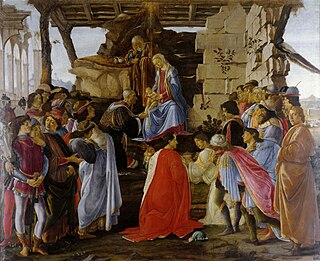
The Adoration of the Magi is a painting by the Italian Renaissance master Sandro Botticelli. Botticelli painted this piece for the altar in Gaspare di Zanobi del Lama's chapel in Santa Maria Novella around 1475. This painting depicts the Biblical story of the Three Magi following a star to find the newborn Jesus. The image of the altarpiece centers on the Virgin Mary and the newborn Jesus, with Saint Joseph behind them. Before them are the three kings who are described in the New Testament story of the Adoration of the Magi. The three kings worship the Christ Child and present him with gifts of gold, frankincense and myrrh. In addition, the Holy Family is surrounded by a group of people who came to see the child who was said to be the son of God.
Lorenzo De Ferrari was an Italian painter of the Baroque period, active mainly in his native city of Genoa.
Pompeo Landulfo was an Italian painter active mainly in Naples. He was born in Maddaloni near Caserta, Italy.
Brescianino has been given as a nickname to:

Andrea del Sarto was an Italian painter from Florence, whose career flourished during the High Renaissance and early Mannerism. He was known as an outstanding fresco decorator, painter of altarpieces, portraitist, draughtsman, and colorist. Although highly regarded during his lifetime as an artist senza errori, his renown was eclipsed after his death by that of his contemporaries Leonardo da Vinci, Michelangelo, and Raphael.

Jacopo Zoboli, also known by Giacomo, was an Italian painter of the Baroque style.

Bernardino de 'Conti was an Italian Renaissance painter, born in 1465 in Castelseprio and died around 1525.
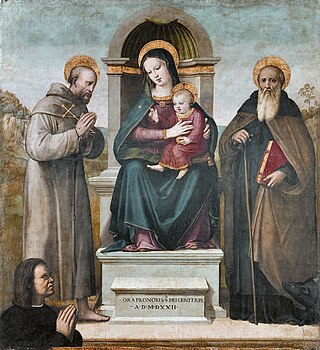
Raffaello del Brescianino or Dei Piccinelli was an Italian painter of the Renaissance period, active in Siena. Together with his brother Andrea, they were known as the Brescianini of Siena. He was the son of a dancing-master at Siena, where he flourished from 1507 to 1525. He was the pupil of a Sienese painter, named Giovan Battista Giusi, and they together painted an altar-piece, representing the 'Virgin and Child, with Saints,' which is in the Siena Academy, and in 1524 the 'Baptism of Christ,' for the baptistery of the cathedral of the same city. In 1525 the brothers went to Florence, and in the same year Andrea, and probably Raffaello also, was registered in the Painters' Guild. The brothers appear to have worked under the influence of Fra Bartolommeo. Raffaello died at Florence in 1545.
Francesco Nasini was an Italian painter of the Baroque period, active mainly in towns outside of Siena, Italy.

Raffaello Sorbi was a 19th-20th century Florentine painter, specializing in narrative painting.